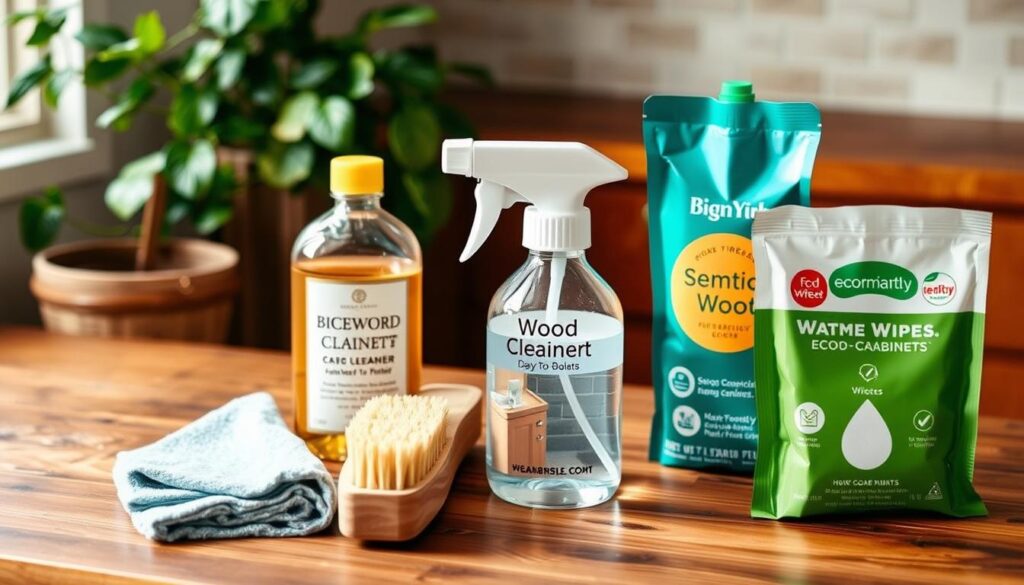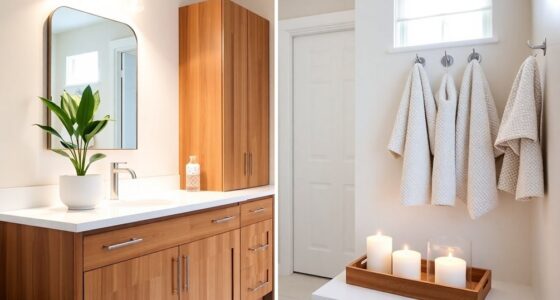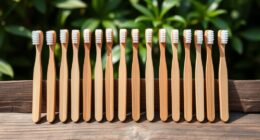Walking into your kitchen should make you feel warm and welcomed. Those wooden cabinets, with their rich look, play a big role in that feeling. But sometimes, they get sticky and grimy from cooking and lose their shine. This is a common problem many face. This guide will show you how to clean sticky wood kitchen cabinets. Doing so will bring back their beauty and keep them as a source of joy in your home.
To fix sticky cabinets, it’s important to know why they get that way. Having the right cleaning supplies and methods is crucial, especially for getting rid of grease. With some effort and the right approaches, you can make your cabinets look as good as new. This will make every time you step into your kitchen a happy moment. Let’s learn how to care for your wooden cabinets so they last long and keep your kitchen looking great.
Key Takeaways
- Wooden kitchen cabinets can accumulate grease and grime, dulling their appearance.
- Dish soap and warm water are effective solutions for cleaning without damaging finishes.
- A baking soda paste is a gentle yet powerful remedy for sticky stains.
- Regular cleaning prevents buildup and extends the life of your cabinets.
- Proper drying after cleaning is essential to avoid water damage to wood.
Understanding the Causes of Stickiness on Wood Cabinets
Sticky wood cabinets often start to happen because of many reasons. Things like grimy fingers, cooking greases, and spills leave a greasy layer. This not only makes your cabinets look bad but can damage them over time. Changes in humidity and temperature also affect your kitchen cabinets a lot.
Common Sources of Greasy Residue
Wooden cabinets in kitchens face many issues every day. Things that make them sticky include:
- Cooking greasy foods that leave a film
- Spills from food and drinks that attract dirt
- Sticky hands touching cabinet surfaces
- Accidental splashes from cleaning products
If you don’t clean them, these things can build up and harm your cabinets’ look and lifespan. Keeping them clean can help a lot.
Environmental Factors Affecting Cabinets
The environment has a big effect on kitchen cabinets too. When it’s very humid, wood can soak up moisture and get sticky. Other things to watch out for include:
- Direct sunlight that softens the finish and makes it sticky
- Temperature changes causing moisture build-up
- Using products like perfumes and hairsprays that add more residue
It’s very important to clean your cabinets regularly. Knowing why cabinets get sticky helps you keep them looking good.
| Source of Greasy Residue | Environmental Factor |
|---|---|
| Cooking oils | Humidity |
| Food spills | Direct sunlight |
| Greasy fingerprints | Temperature fluctuations |
| Cleaning product spills | Bathroom products |
Gathering Your Cleaning Supplies
To efficiently clean sticky wood kitchen cabinets, you need the right supplies. These tools help you clean better and keep your cabinets safe. Choose supplies that clean deeply but also look after the wood’s finish. Here’s what you’ll need, including top products for a careful and effective clean.
Essential Items You’ll Need
- Mild dish soap
- Baking soda
- White vinegar
- Microfiber cloths
- Sponges
- Towels
- A soft-bristled brush or toothbrush
Recommended Cleaning Products
For the best results, think about these wood cleaner products:
| Product Name | Type | Notes |
|---|---|---|
| Murphy’s Oil Soap | Liquid Cleaner | Great for safe cleaning of finished wood surfaces. |
| Weiman Wood Cleaner | Aerosol Spray | It shines as it cleans and is safe for frequent use. |
Make sure to stay away from harsh chemicals and rough cleaners when picking cleaning supplies for wood cabinets. These can harm the wood’s color and condition. Look for products with a pH level of 6 to 8 for a safe clean. Be mindful of the ingredients in wood cleaners. Always check the label and do a small test before using it widely.

How to Clean Sticky Wood Kitchen Cabinets
To clean sticky wood cabinets well, you need to first empty them completely. This lets you get right to the stains and gunk. It prepares you to clean thoroughly and bring back the shine.
Step-by-Step Cleaning Process
Check how sticky the cabinets are first. For a bit of grease, mix warm water with a drop of gentle dish soap. Then, take a microfiber cloth, and gently wipe the cabinets, especially the handles.
If you find really sticky spots, make a baking soda paste. Put this paste on, wait a bit, then scrub softly with a brush. This keeps your cabinets safe while getting rid of the nasty stuff.
Using Baking Soda and Vinegar Effectively
Baking soda is a super cleaner for inside cabinets. Mix it with water to handle tough stains. If you add vinegar to it, it’s even more powerful. Use half vinegar, half warm water for a good clean. Just remember to rinse it all off so you don’t damage the wood.
DIY Cleaner Recipe for Wood Cabinets
Here’s a cool DIY cleaner: mix one cup vinegar, one cup warm water, and a teaspoon of gentle dish soap. This mix doesn’t just clean; it makes your cabinets look fresh. After cleaning, put on some light polish, like olive oil, to make the wood shine. Clean often to keep them looking great.

Maintaining Your Wood Cabinets for Long-Term Cleanliness
To keep your wood cabinets looking great, regular care is key. A consistent clean-up plan helps stop them from getting sticky. Here are some top tips for taking care of your cabinets.
Regular Maintenance Tips
- Wipe down cabinets daily to remove grease and dust, reducing sticky residue buildup.
- Use a microfiber cloth and a gentle cleaner at least once a week for a thorough cleaning.
- Schedule deeper cleaning sessions every three to four months to catch any hidden grime.
- Consider emptying cabinets periodically to clean the interiors and check for moisture.
- Maintain a stable indoor humidity level between 35% and 50% to prevent warping.
- For tough stains, a solution of 50% water and 50% vinegar can be very effective.
Preventative Measures to Avoid Stickiness
It’s important to use preventative measures to care for cabinets long-term. Here are some good strategies:
- Avoid harsh chemicals and petroleum-based products that can harm finishes.
- Use specialized, high-quality polishes without silicone or wax to prevent scratches.
- Protect cabinets from direct sunlight through the use of window coverings, reducing fading.
- Be quick to address spills and moisture, wiping immediately to prevent damage.
- Utilize cabinet liners to safeguard surfaces from stains within the cabinet.

Conclusion
Cleaning wood kitchen cabinets may seem hard, but it’s really not. With the right know-how and tips, you can easily tackle it. You’ve learned about the main causes of sticky cabinets. And you know how to fix them with simple solutions. Using DIY mixes like vinegar and water is key to keeping your cabinets clean.
This helps make sure your finishes last longer, too. Keeping your cabinets clean regularly is important. It stops sticky stuff from coming back. Make sure to clean often, especially in spots that get dirty easily.
Adding mild soaps and sometimes using wax or polish keeps your cabinets looking good. And it helps them stay clean longer. By following this guide, your kitchen will stay clean and cozy. Clean your wooden cabinets often, use the tips you’ve learned, and your kitchen will stay looking great for many years!









